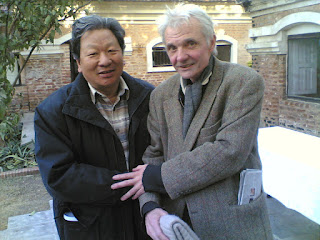of] aif{sf] a8fbz}+ t/fOsf anfn du/ x?n] alx:sf/ u/] . sf7df08'sfxfdLn] eg] l6sf nufof}+ . /fhlgltsf sf/0f rf8kj{x? klg ljjfbdf k/]sf 5g\ . o;f] x'g' /fd|f] xf]Og . I found a good news of social importance: Hindus and Budhists celebrated Dasain unitedly in Taksera of Rukum in Nepal.
रुकुम, कार्तिक १३ -
तकसेराको एक गुम्बामा यहाँका बौद्ध धर्मावलम्बी र हिन्दुले सँगै दसैँ मनाएका छन् । दुवै धर्मको सम्मान गर्दै दशमीको दिनदेखि कोज्रागत पूणिर्मासम्म नाचगान र टीकाटाला गर्दै हिन्दु र बौद्ध धर्मावलम्बीले सँगै दसैँ मनाएका हुन् ।
ढोरपाटन सिकार आरक्षभित्र पर्ने ढोरपाटन गुम्बामा हिन्दु र बौद्ध धर्मावलम्बीले मान्यजनको हातबाट टीका थाप्दै नाचगानसहित दसैँ मनाएको बौद्ध भिक्षु कर्ण लामाले बताए । ५ दिनसम्म मनाइएको सामूहिक दसैँमा १ सय ५० भन्दा बढी स्थानीय हिन्दु र बौद्ध धर्मावलम्बीले दसैँ मनाएको लामाले जनाए । 'दसैँलाई आत्मीयता बाँड्ने, भाइचारा बढाउने र धार्मिक सहिष्णुता प्रदर्शन गर्ने अवसरका रूपमा मनाएका छौँ,' उनले भने, 'विजयादशमीदेखि पूणिर्मासम्म दुवै धर्मावलम्बीले सँगै नाचगानसमेत गर्यौँ ।' सामूहिक दसैँ मनाउँदा आपसी भ्रातृत्व र एकअर्काबीचको धार्मिक आस्थाको कदर हुने भन्दै सामूहिक दसैँ मनाइएको स्थानीयले जनाएका छन् । बौद्ध धर्मावलम्बीले अहिंसा अँगाल्ने भएकाले यसपालि सामूहिक दसैँ मनाउनेले बलि नदिएरै साकाहारी दसैँ मनाए । बुद्ध धर्मावलम्बीसँगै हिन्दुले साकाहारी दसैँ मनाएर नयाँ सन्देश दिन खोजेको लामाले जनाए ।
प्रकाशित मिति: २०६९ कार्तिक १४ ०८:५७
Vijayadashami or Dashara or Dussehra or Dasain is celebrated by people in their own way throughout Nepal despite of their caste, religion, culture and practices. Different communities have linked it with their own historical events--Hindus have linked it with the victory of good over evil; Buddhists have taken it as an occasion when king Ashoka turned into Budhhist…etc..etc..Vijayadashami is celebrated not only in Nepal but also in India and Bangladesh. This festival is known with different names in different parts of the world as: (Bengali: বিজয়াদশমী, Kannada: ವಿಜಯದಶಮಿ, Malayalam: വിജയദശമി, Marathi: विजयादशमी, Nepali: विजया दशमी, Oriya: ବିଜୟାଦଶମୀ, Tamil: விஜயதசமி, Telugu: విజయదశమి, Konkani: दसरो, Punjabi: ਦਸੇਰਾ) also known as Dashahara, Dussehra, Dashain (in Nepal), Navratri or Durgotsav is one of the most important Hindu festivals celebrated in various forms, across India, Nepal and Bangladesh.
The name Dussehra is derived from Sanskrit Dasha-hara literally means remover of ten referring to Lord Rama's victory over the ten-headed demon king Ravana.[1] The day also marks the victory of Goddess Durga over the demons Mahishasur. The name Vijayadashami is also derived from the Sanskrit words "Vijaya-dashmi" literally meaning the victory on the dashmi (Dashmi being the tenth lunar day of the Hindu calendar month).
Read more from Wikipedia
